A Quantitative Literature Review on Forest-Based Practices for Human Well-Being
Abstract
1. Introduction
1.1. Literature Review on Forest Bathing and Forest Therapy
1.2. Motivations and Aims of the Study
2. Materials and Methods
2.1. Text Mining
2.1.1. Implementation of Database
2.1.2. Statistical Analysis of Corpus
2.2. PRISMA
Literature Search and Eligibility of Criteria
3. Results
3.1. Text Mining
3.1.1. Overall Analysis of Corpus
3.1.2. Multidimensional Scaling
3.2. PRISMA Outputs
4. Discussion and Conclusion
Supplementary Materials
Author Contributions
Funding
Data Availability Statement
Acknowledgments
Conflicts of Interest
References
- Cleveland, T., Jr. National Forests as Recreation Grounds. Ann. Am. Acad. Political Soc. Sci. 1910, 35, 25–31. [Google Scholar] [CrossRef]
- Adewuyi, F.A.; Knobel, P.; Gogna, P.; Dadvand, P. Health effects of green prescription: A systematic review of randomized controlled trials. Environ. Res. 2023, 236, 116844. [Google Scholar] [CrossRef] [PubMed]
- Park, B.J.; Tsunetsugu, Y.; Kasetani, T.; Hirano, H.; Kagawa, T.; Sato, M.; Miyazaki, Y. Physiological Effects of Shinrin-Yoku (Taking in the Atmosphere of the Forest)—Using Salivary Cortisol and Cerebral Activity as Indicators. J. Physiol. Anthropol. 2007, 26, 123–128. [Google Scholar] [CrossRef] [PubMed]
- Li, Q. New Concept of Forest Medicine. Forests 2023, 14, 1024. [Google Scholar] [CrossRef]
- McEwan, K.; Giles, D.; Clarke, F.J.; Kotera, Y.; Evans, G.; Terebenina, O.; Minou, L.; Teeling, C.; Basran, J.; Wood, W.; et al. A Pragmatic Controlled Trial of Forest Bathing Compared with Compassionate Mind Training in the UK: Impacts on Self-Reported Well-being and Heart Rate Variability. Sustainability 2021, 13, 1380. [Google Scholar] [CrossRef]
- Kaplan, R.; Kaplan, S. The Experience of Nature: A Psychological Perspective; Cambridge University Press: Cambridge, UK, 1989. [Google Scholar]
- Yamaguchi, M.; Deguchi, M.; Miyazaki, Y. The Effects of Exercise in Forest and Urban Environments on Sympathetic Nervous Activity of Normal Young Adults. J. Int. Med. Res. 2006, 34, 152–159. [Google Scholar] [CrossRef]
- Li, Q.; Morimoto, K.; Nakadai, A.; Inagaki, H.; Katsumata, M.; Shimizu, T.; Hirata, Y.; Hirata, K.; Suzuki, H.; Miyazaki, Y.; et al. Forest bathing enhances human natural killer activity and expression of anti-cancer proteins. Int. J. Immunopathol. Pharmacol. 2007, 20, 3–8. [Google Scholar] [CrossRef]
- Li, Q. Effect of forest bathing trips on human immune function. Environ. Health Prev. Med. 2010, 15, 9–17. [Google Scholar] [CrossRef]
- Clifford, A. Your Guide to Forest Bathing; Conari Press: Berkeley, CA, USA, 2018. [Google Scholar]
- Paletto, A.; Notaro, S.; Pavaleanu, C. Forest Bathing: A Quantitative Exploration of Emerging Trends, Patterns, and Growth Areas. J. For. Res. 2024, 29, 239–245. [Google Scholar] [CrossRef]
- Kim, J.G.; Shin, W.S. Forest Therapy Alone or with a Guide: Is There a Difference between Self-Guided Forest Therapy and Guided Forest Therapy Programs? Int. J. Environ. Health Res. 2021, 18, 6957. [Google Scholar] [CrossRef]
- Gobster, P.H.; Schultz, C.L.; Kruger, L.E.; Henderson, J.R. Forest Therapy Trails: A Conceptual Framework and Scoping Review of Research. Forests 2022, 13, 1613. [Google Scholar] [CrossRef]
- Hansen, M.M.; Jones, R.; Tocchini, K. Shinrin-yoku (Forest bathing) and nature therapy: A state-of-the-art review. Int. J. Environ. Res. Public Health 2017, 14, 851. [Google Scholar] [CrossRef] [PubMed]
- Lakhani, A.; Norwood, M.; Watling, D.P.; Zeeman, H.; Kendall, E. Using the natural environment to address the psychosocial impact of neurological disability: A systematic review. Health Place 2019, 55, 188–201. [Google Scholar] [CrossRef] [PubMed]
- Park, S.; Kim, S.; Kim, G.; Choi, Y.; Kim, E.; Paek, D. Evidence-Based Status of Forest Healing Program in South Korea. Int. J. Environ. Res. Public Health 2021, 18, 10368. [Google Scholar] [CrossRef]
- Harper, N.J.; Fernee, C.R.; Gabrielsen, L.E. Nature’s role in outdoor therapies: An umbrella review. Int. J. Environ. Res. Public Health 2021, 18, 5117. [Google Scholar] [CrossRef]
- Immich, G.; Robl, E. Development of Structural Criteria for the Certification and Designation of Recreational and Therapeutic Forests in Bavaria, Germany. Forests 2023, 14, 1273. [Google Scholar] [CrossRef]
- Jones, R.J.F.; Littzen, C.O.R. An Analysis of Theoretical Perspectives in Research on Nature-Based Interventions and Pain. Int. J. Environ. Res. Public Health 2022, 19, 12740. [Google Scholar] [CrossRef]
- Chae, Y.; Lee, S.; Jo, Y.; Kang, S.; Park, S.; Kang, H. The effects of forest therapy on immune function. Int. J. Environ. Res. Public Health 2021, 18, 8440. [Google Scholar] [CrossRef]
- Yau, K.K.-Y.; Loke, A.Y. Effects of forest bathing on pre-hypertensive and hypertensive adults: A review of the literature. Environ. Health Prev. Med. 2020, 25, 23. [Google Scholar] [CrossRef]
- Mei, P.; Malik, V.; Harper, R.W.; Jiménez, J.M. Air pollution, human health and the benefits of trees: A biomolecular and physiologic perspective. Arboric. J. 2021, 43, 19–40. [Google Scholar] [CrossRef]
- Antonelli, M.; Donelli, D.; Barbieri, G.; Valussi, M.; Maggini, V.; Firenzuoli, F. Forest Volatile Organic Compounds and Their Effects on Human Health: A State-of-the-Art Review. Int. J. Environ. Res. Public Health 2020, 17, 6506. [Google Scholar] [CrossRef]
- Andersen, L.; Corazon, S.S.; Stigsdotter, U.K. Nature Exposure and Its Effects on Immune System Functioning: A Systematic Review. Int. J. Environ. Res. Public Health 2021, 18, 1416. [Google Scholar] [CrossRef] [PubMed]
- Roviello, V.; Gilhen-Baker, M.; Vicidomini, C.; Roviello, G.N. Forest-bathing and physical activity as weapons against COVID-19: A review. Environ. Chem. Lett. 2022, 20, 131–140. [Google Scholar] [CrossRef] [PubMed]
- Timko Olsen, E.R.; Olson, A.A.; Driscoll, M.; Vermeesch, A.L. Nature-Based Interventions and Exposure among Cancer Survivors: A Scoping Review. Int. J. Environ. Res. Public Health 2023, 20, 2376. [Google Scholar] [CrossRef] [PubMed]
- Timko Olsen, E.R.; Hansen, M.M.; Vermeesch, A. Mindfulness and Shinrin-yoku: Potential for physiological and psychological interventions during uncertain times. Int. J. Environ. Res. Public Health 2020, 17, 9340. [Google Scholar] [CrossRef]
- Grilli, G.; Sacchelli, S. Health Benefits Derived from Forest: A Review. Int. J. Environ. Res. Public Health 2020, 17, 6125. [Google Scholar] [CrossRef]
- Berghmans, C. The impact of exposure to nature (forest bathing) on mental health: A review of randomized controlled trials and an analysis of action processes. Evol. Psychiatr. 2023, 89, 811–828. [Google Scholar] [CrossRef]
- Chun, H.-R.; Choi, Y.-Y.; Cho, I.; Nam, H.-K.; Kim, G.; Park, S.; Cho, S.-I. Indicators of the Psychosocial and Physiological Effects of Forest Therapy: A Systematic Review. Forests 2023, 14, 1407. [Google Scholar] [CrossRef]
- Mazzoleni, E.; Donelli, D.; Zabini, F.; Meneguzzo, F.; Antonelli, M. Forest Therapy Research in Europe: A Scoping Review of the Scientific Literature. Forests 2024, 15, 848. [Google Scholar] [CrossRef]
- Lopes, M.K.S.; Falk, T.H. Audio-visual-olfactory immersive digital nature exposure for stress and anxiety reduction: A systematic review on systems, outcomes, and challenges. Front. Virtual Real. 2024, 5, 1252539. [Google Scholar] [CrossRef]
- Ramos, M.R.; Santos, L.; do Céu Salvador, M.; Nobre Lima, L.; Rijo, D. Effectiveness of mental-health interventions for children and adolescents placed in residential care by the welfare services: A systematic review. Child. Youth Serv. Rev. 2024, 166, 107929. [Google Scholar] [CrossRef]
- Szitás, D.; Halamová, J.; Ottingerová, L.; Schroevers, M. The effects of forest bathing on self-criticism, self-compassion, and self-protection: A systematic review. J. Environ. Psychol. 2024, 97, 102372. [Google Scholar] [CrossRef]
- Rajoo, K.S.; Karam, D.S.; Abdullah, M.Z. The physiological and psychosocial effects of forest therapy: A systematic review. Urban For. Urban Green. 2020, 54, 126744. [Google Scholar] [CrossRef]
- Doimo, I.; Masiero, M.; Gatto, P. Forest and Well-being: Bridging Medical and Forest Research for Effective Forest-Based Initiatives. Forests 2020, 11, 791. [Google Scholar] [CrossRef]
- Mathias, S.; Daigle, P.; Dancause, K.N.; Gadais, T. Forest bathing: A narrative review of the effects on health for outdoor and environmental education use in Canada. J. Outdoor Environ. Educ. 2020, 23, 309–321. [Google Scholar] [CrossRef]
- Stier-Jarmer, M.; Throner, V.; Kirschneck, M.; Immich, G.; Frisch, D.; Schuh, A. The Psychological and Physical Effects of Forests on Human Health: A Systematic Review of Systematic Reviews and Meta-Analyses. Int. J. Environ. Res. Public Health 2021, 18, 1770. [Google Scholar] [CrossRef]
- Shim, S.R.; Chang, J.K.; Lee, J.; Byeon, W.J.; Lee, J.; Lee, K.J. Perspectives on the Psychological and Physiological Effects of Forest Therapy: A Systematic Review with a Meta-Analysis and Meta-Regression. Forests 2022, 13, 2029. [Google Scholar] [CrossRef]
- Cvikl, D. Forest Therapy and Well-being Tourism Literature Review—With Assessment of Potential for Slovenia. Acad. Tur. 2022, 15, 25–41. [Google Scholar] [CrossRef]
- He, M.; Hu, Y.; Wen, Y.; Wang, X.; Wei, Y.; Sheng, G.; Wang, G. The Impacts of Forest Therapy on the Physical and Mental Health of College Students: A Review. Forests 2024, 15, 682. [Google Scholar] [CrossRef]
- Gao, D.; Shen, J.; Gao, Y.; Zhang, Z. The Beneficial Elements in Forest Environment Based on Human Health and Well-being Perspective. Forests 2024, 15, 1604. [Google Scholar] [CrossRef]
- Piva, G.; Caruso, L.; Cruz Gómez, A.; Calzolari, M.; Visintin, E.P.; Davoli, P.; Manfredini, F.; Storari, A.; Spinozzi, P.; Lamberti, N. Effects of forest walking on physical and mental health in elderly populations: A systematic review. Rev. Environ. Health 2024, 39, 121–136. [Google Scholar] [CrossRef]
- Droli, M.; Sigura, M.; Vassallo, F.G.; Droli, G.; Iseppi, L. Evaluating Potential Respiratory Benefits of Forest-Based Experiences: A Regional Scale Approach. Forests 2022, 13, 387. [Google Scholar] [CrossRef]
- Antonelli, M.; Donelli, D.; Carlone, L.; Maggini, V.; Firenzuoli, F.; Bedeschi, E. Effects of forest bathing (Shinrin-yoku) on individual well-being: An umbrella review. Int. J. Environ. Health Res. 2022, 32, 1842–1867. [Google Scholar] [CrossRef]
- Luederitz, C.; Brink, E.; Gralla, F.; Hermelingmeier, V.; Meyer, M.; Niven, L.; Panzer, L.; Partelow, S.; Rau, A.L.; Sasaki, R.; et al. A review of urban ecosystem services: Six key challenges for future research. Ecosyst. Serv. 2015, 14, 98–112. [Google Scholar] [CrossRef]
- Sacchelli, S.; Borghi, C.; Fratini, R.; Bernetti, I. Assessment and valorization of non-wood forest products in Europe: A quantitative literature review. Sustainability 2021, 13, 3533. [Google Scholar] [CrossRef]
- Berry, M.W.; Kogan, J. Text Mining: Application and Theory; Wiley: Hoboken, NJ, USA, 2010. [Google Scholar]
- Schober, A.; Šimunović, N.; Darabant, A.; Stern, T. Identifying sustainable forest management research narratives: A text mining approach. J. Sustain. For. 2018, 37, 537–554. [Google Scholar] [CrossRef]
- United Nations, Department of Economic and Social Affairs, Population Division. World Population Prospects: The 2012 Revision, Highlights and Advance Tables; Working Paper No. ESA/P/WP.228; United Nations, Department of Economic and Social Affairs, Population Division: New York, NY, USA, 2013; pp. ix–xiii. [Google Scholar]
- Bolasco, S.; Pavone, P. Automatic Dictionary- and Rule-Based Systems for Extracting Information from Text. In Data Analysis and Classification. Studies in Classification, Data Analysis, and Knowledge Organization; Palumbo, F., Lauro, C., Greenacre, M., Eds.; Springer: Berlin/Heidelberg, Germany, 2010. [Google Scholar] [CrossRef]
- Sammon, J.W. A Nonlinear Mapping for Data Structure Analysis. IEEE Trans. Comput. 1969, 18, 401–409. [Google Scholar] [CrossRef]
- Borg, I.; Groenen, P. Modern Multidimensional Scaling: Theory and Applications, 2nd ed.; Springer: New York, NY, USA, 2005; pp. 207–212. [Google Scholar]
- Page, M.J.; McKenzie, J.E.; Bossuyt, P.M.; Boutron, I.; Hoffmann, T.C.; Mulrow, C.D.; Shamseer, L.; Tetzlaff, J.M.; Akl, E.A.; Brennan, S.E.; et al. The PRISMA 2020 statement: An updated guideline for reporting systematic reviews. BMJ 2021, 372, 71. [Google Scholar] [CrossRef]
- Zhang, Y.; Feng, L.; Duan, W. The Impact of Forest Therapy Programs on Stress Reduction: A Systematic Review. Forests 2023, 14, 1851. [Google Scholar] [CrossRef]
- OECD. Gross Domestic Spending on R&D; OECD: Paris, France, 2025; Available online: https://www.oecd.org/en/data/indicators/gross-domestic-spending-on-r-d.html (accessed on 3 May 2025).
- Wickelmaier, F. An introduction to MDS. 2003. Available online: https://www.hongfeili.com/files/paper100/paper4.pdf (accessed on 4 May 2025).
- Grilli, G.; Barbierato, E.; Capecchi, I.; Sacchelli, S. Application of stated-preferences methods and neuroscience for the valuation of dynamicity in forest cultural ecosystem services. J. Environ. Plan. Manag. 2022, 65, 398–417. [Google Scholar] [CrossRef]
- Paletto, A.; Notaro, S.; Sergiacomi, C.; Di Mascio, F. The Economic Value of Forest Bathing: An Example Case of the Italian Alps. Forests 2024, 15, 543. [Google Scholar] [CrossRef]
- Tsunetsugu, Y.; Park, B.J.; Lee, J.; Kagawa, T.; Miyazaki, Y. Psychological relaxation effect of forest therapy: Results of field experiments in 19 forests in Japan involving 228 participants. Jpn. J. Hyg. 2011, 66, 670–676. [Google Scholar] [CrossRef]
- Morita, E.; Imai, M.; Okawa, M.; Miyaura, T.; Miyazaki, S. A before and after comparison of the effects of forest walking on the sleep of a community-based sample of people with sleep complaints. Biopsychosoc. Med. 2011, 5, 13. [Google Scholar] [CrossRef]
- Li, Q.; Kobayashi, M.; Wakayama, Y.; Inagaki, H.; Katsumata, M.; Hirata, Y.; Li, Y.; Hirata, K.; Shimizu, T.; Suzuki, H.; et al. Effect of forest environments on psychological response evaluated by the POMS test. In Forest Medicine; Li, Q., Ed.; Nova Science Publisher: New York, NY, USA, 2012; pp. 137–146. [Google Scholar]
- Lee, I.; Choi, H.; Bang, K.-S.; Kim, S.; Song, M.; Lee, B. Effects of Forest Therapy on Depressive Symptoms among Adults: A Systematic Review. Int. J. Environ. Res. Public Health 2017, 14, 321. [Google Scholar] [CrossRef] [PubMed]
- Chun, M.H.; Chang, M.C.; Lee, S.J. The effects of forest therapy on depression and anxiety in patients with chronic stroke. Int. J. Neurosci. 2017, 127, 199–203. [Google Scholar] [CrossRef] [PubMed]
- Jia, B.B.; Yang, Z.X.; Mao, G.X.; Lyu, Y.D.; Wen, X.L.; Xu, W.H.; Lyu, X.L.; Cao, Y.B.; Wang, G.F. Health Effect of Forest Bathing Trip on Elderly Patients with Chronic Obstructive Pulmonary Disease. Biomed. Environ. Sci. 2016, 29, 212–218. [Google Scholar] [CrossRef] [PubMed]
- Bielinis, E.; Takayama, N.; Boiko, S.; Omelan, A.; Bielinis, L. The effect of winter forest bathing on psychological relaxation of young Polish adults. Urban For. Urban Green. 2018, 29, 276–283. [Google Scholar] [CrossRef]
- Karjalainen, E.; Sarjala, T.; Raitio, H. Promoting human health through forests: Overview and major challenges. Environ. Health Prev. Med. 2010, 15, 1–8. [Google Scholar] [CrossRef]
- Gürbey, A.P.; Karabudak, G. Forest Bathing as an Eco-Wellness Tourism Activity. In Theories, Techniques, Strategies for Spatial Planners and Designers: Planning, Design, Applications; Peter Lang: Lausanne, Switzerland, 2021; pp. 691–712. [Google Scholar]
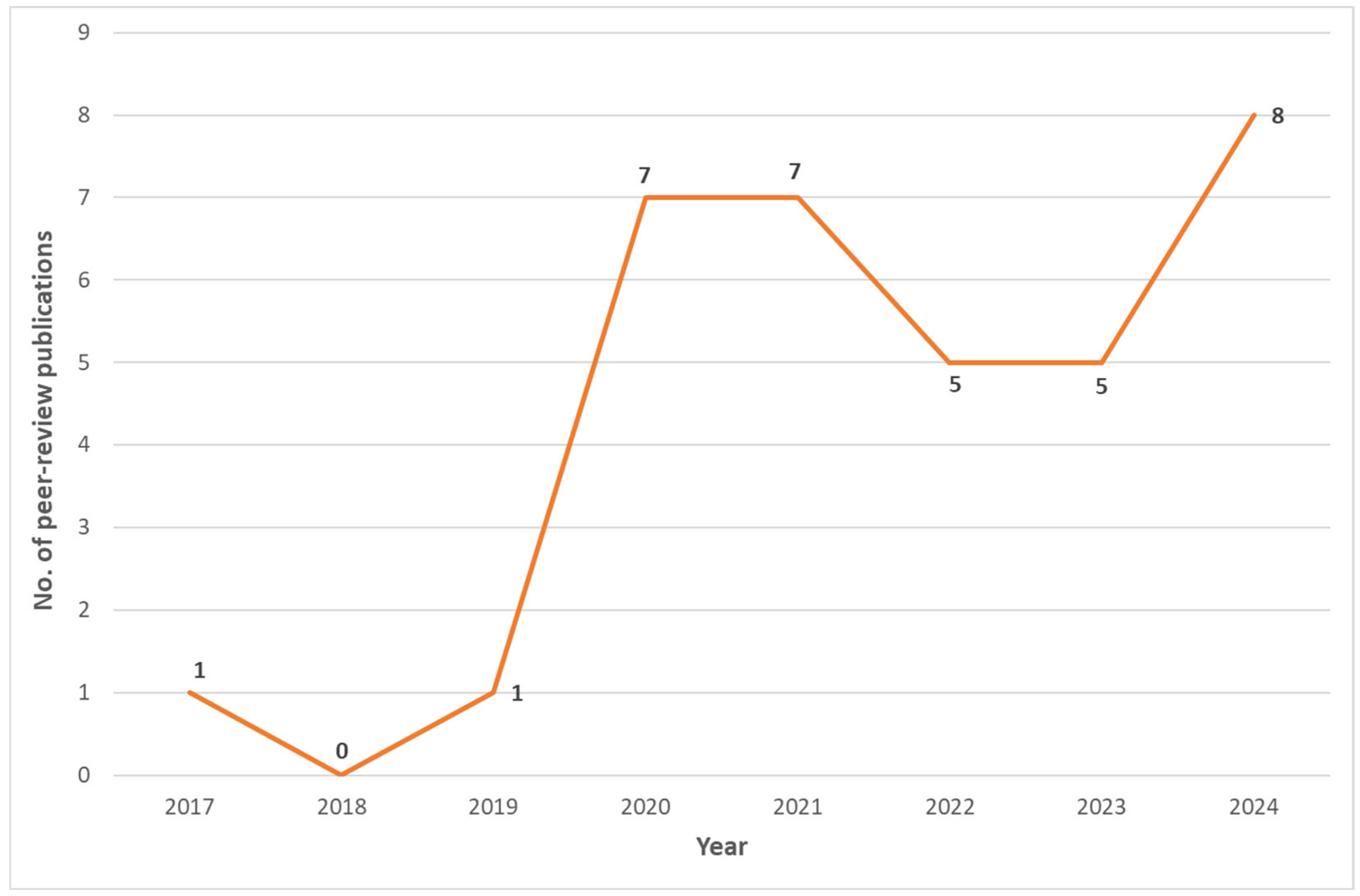
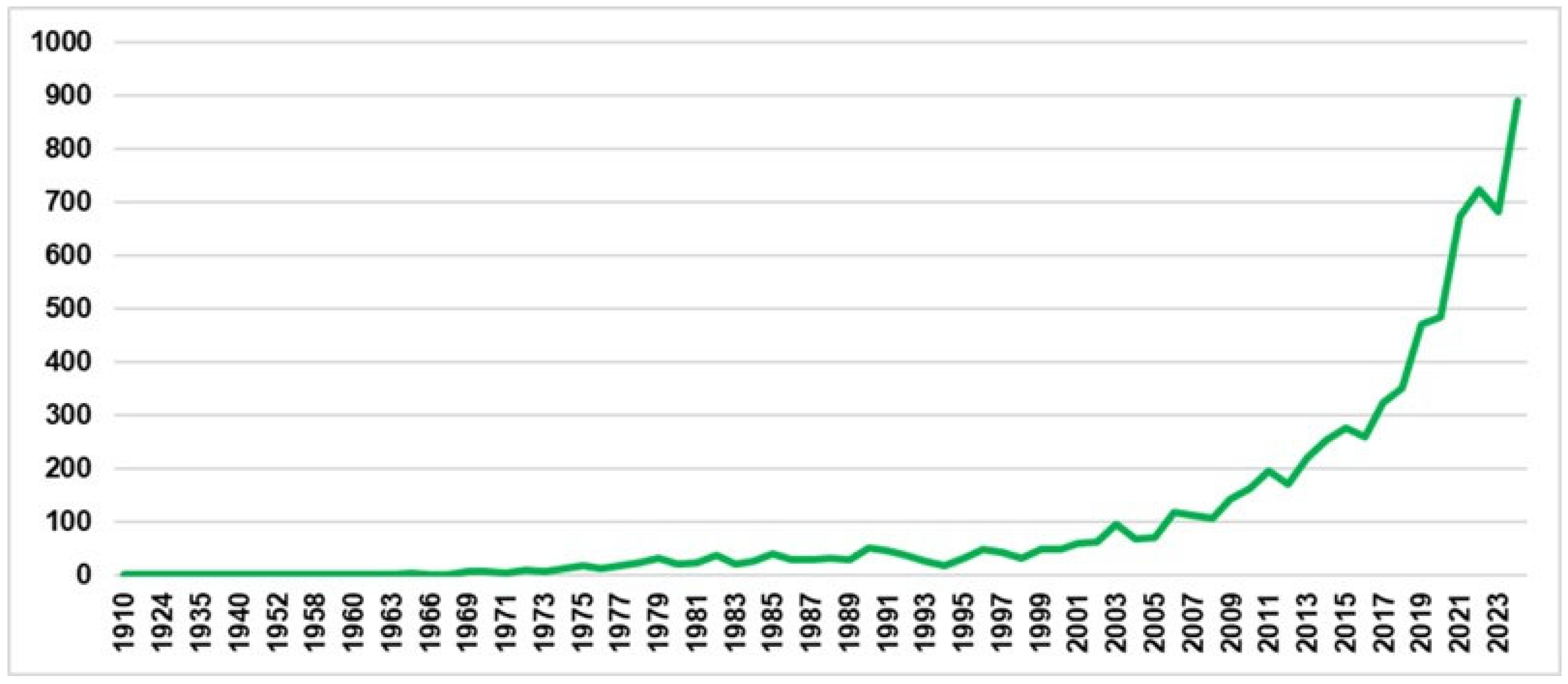
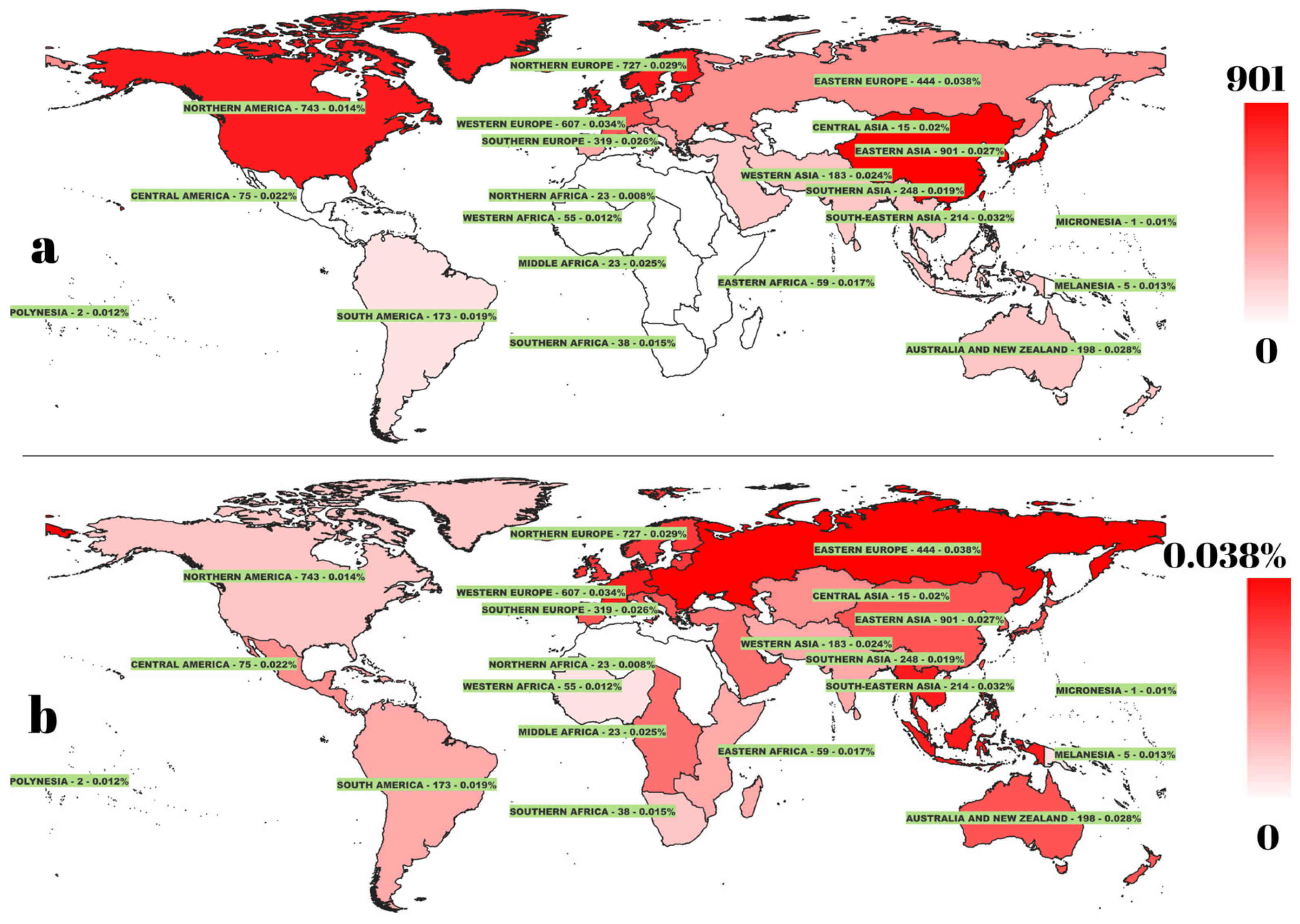
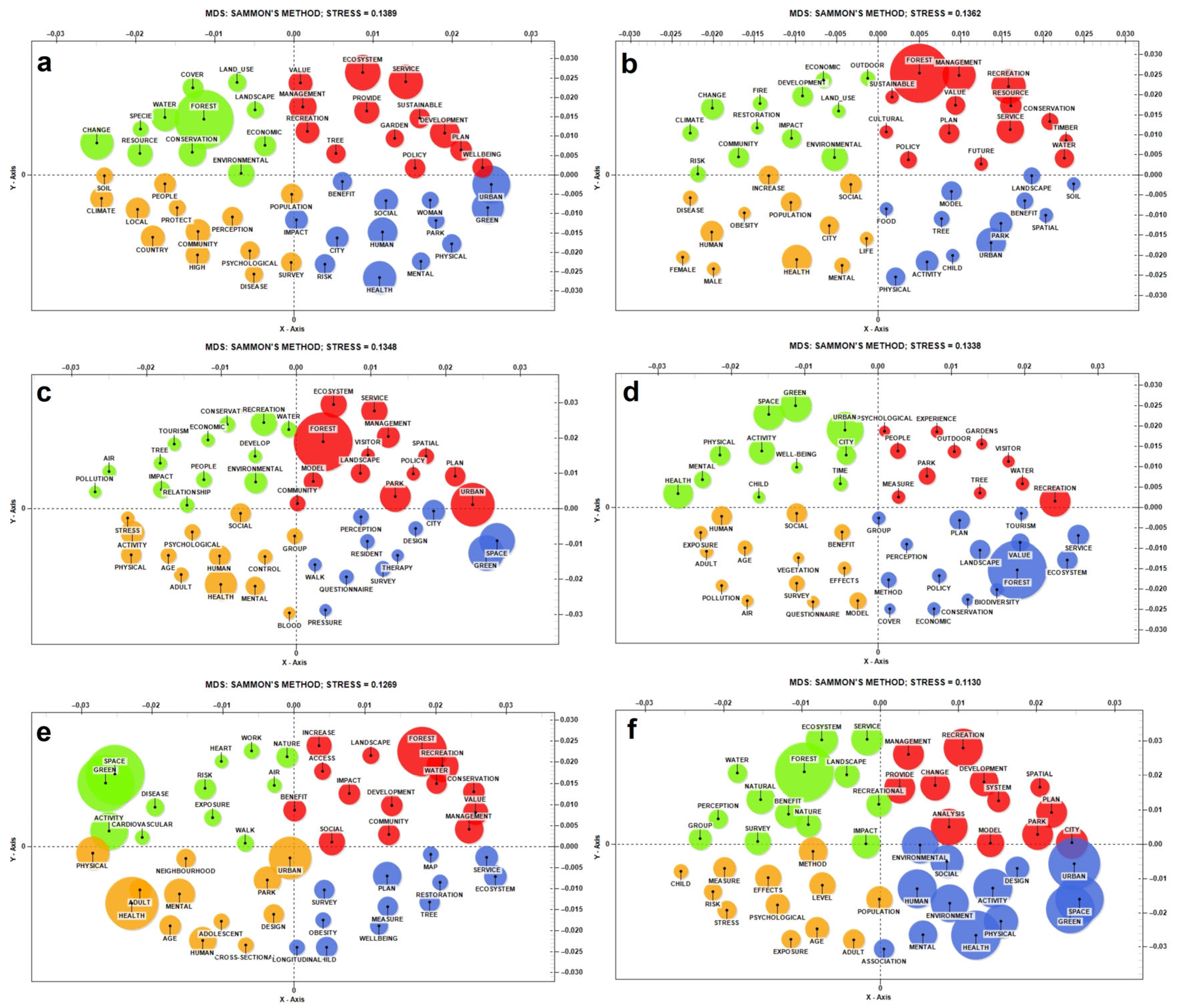
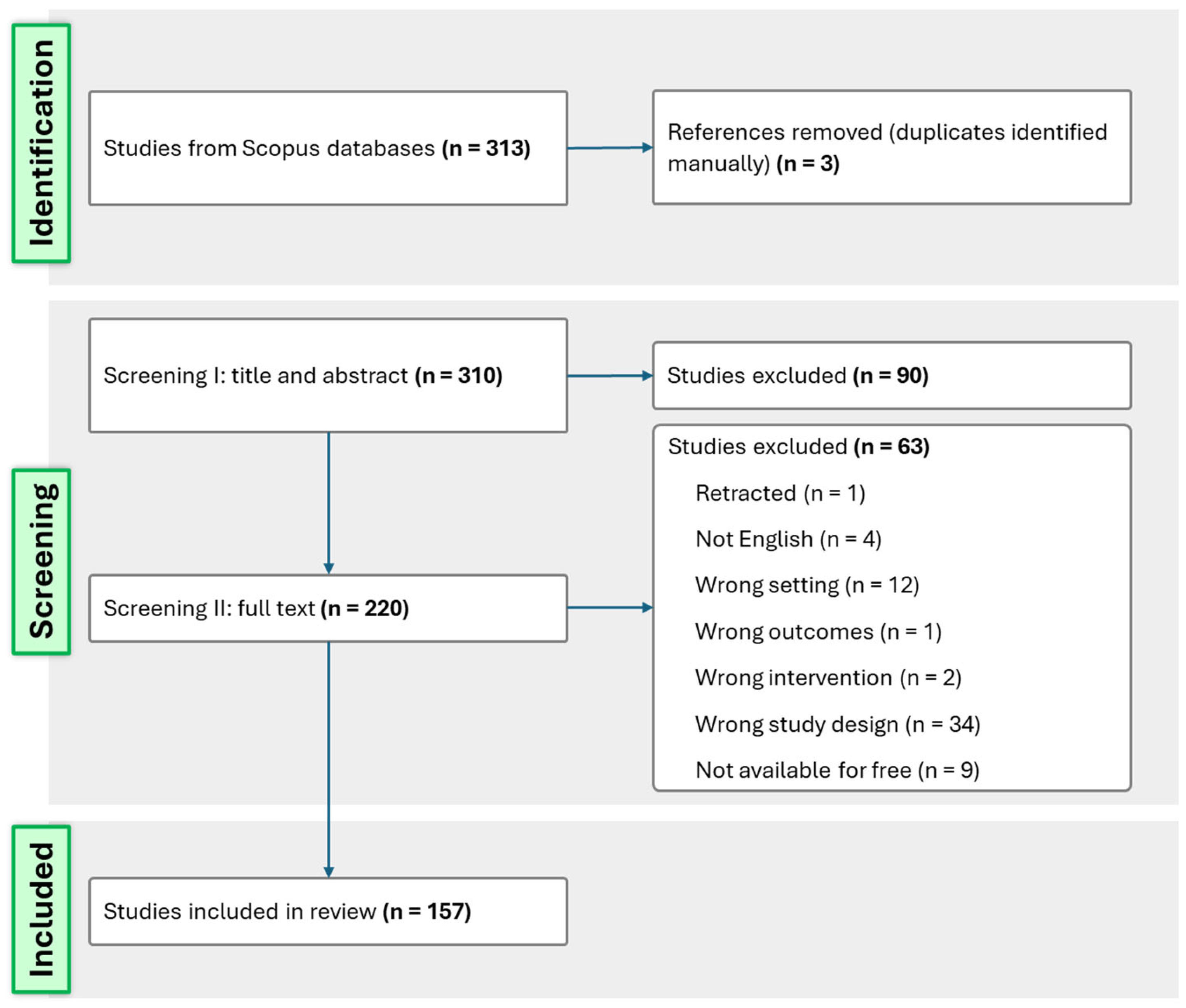
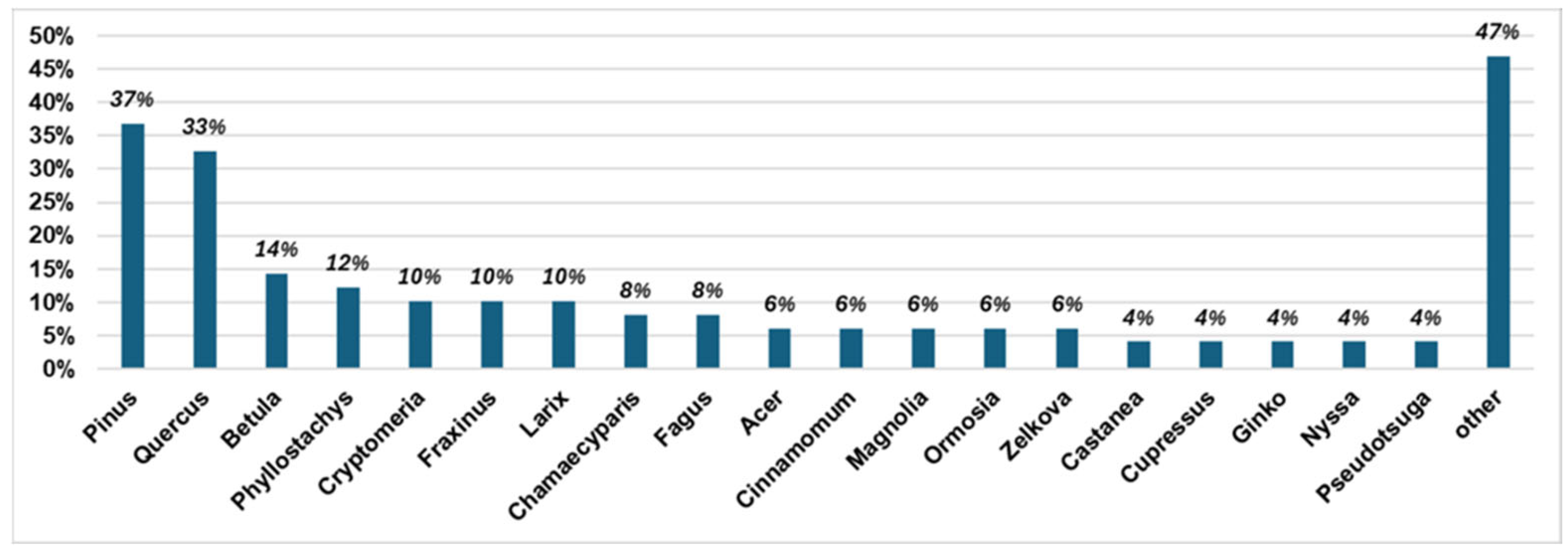
| Forest Setting | Forest Variable | ||
|---|---|---|---|
| Real forest | 69.6% | Tree species | 40.9% |
| VR forest | 14.5% | Density/coverage | 10.1% |
| Photo with forest | 9.0% | Age | 8.1% |
| Video with forest | 3.4% | Diameter/height | 2.0% |
| Only audio | 2.1% | Leaf typology | 0.7% |
| Essential oils | 1.4% | ||
| Total | 100.0% | 61.8% | |
| Season or Season Combination | Percentage |
|---|---|
| Summer | 23.8% |
| Autumn | 15.9% |
| Spring/Autumn/Winter | 6.6% |
| Winter | 6.0% |
| All | 2.6% |
| Summer/Autumn | 2.0% |
| Summer/Winter | 2.0% |
| Spring/Summer/Autumn | 2.0% |
| Spring/Summer | 1.3% |
| Autumn/Winter | 0.7% |
| Spring/Winter | 0.7% |
| Total | 63.6% |
| Physiological Measurement Category | Number of Paper | Percentage |
|---|---|---|
| Cardiovascular | 121 | 77.6% |
| Biochemical | 35 | 22.4% |
| Neurological | 29 | 18.6% |
| Skin conductance | 13 | 8.3% |
| Immunological | 6 | 3.8% |
| Metabolic Systems | 2 | 1.3% |
| Eyes movements | 2 | 1.3% |
| Respiratory | 1 | 0.6% |
Disclaimer/Publisher’s Note: The statements, opinions and data contained in all publications are solely those of the individual author(s) and contributor(s) and not of MDPI and/or the editor(s). MDPI and/or the editor(s) disclaim responsibility for any injury to people or property resulting from any ideas, methods, instructions or products referred to in the content. |
© 2025 by the authors. Licensee MDPI, Basel, Switzerland. This article is an open access article distributed under the terms and conditions of the Creative Commons Attribution (CC BY) license (https://creativecommons.org/licenses/by/4.0/).
Share and Cite
Paletto, A.; Baldessari, S.; Barbierato, E.; Bernetti, I.; Cerutti, A.; Righi, S.; Ruggieri, B.; Landi, A.; Notaro, S.; Sacchelli, S. A Quantitative Literature Review on Forest-Based Practices for Human Well-Being. Forests 2025, 16, 1246. https://doi.org/10.3390/f16081246
Paletto A, Baldessari S, Barbierato E, Bernetti I, Cerutti A, Righi S, Ruggieri B, Landi A, Notaro S, Sacchelli S. A Quantitative Literature Review on Forest-Based Practices for Human Well-Being. Forests. 2025; 16(8):1246. https://doi.org/10.3390/f16081246
Chicago/Turabian StylePaletto, Alessandro, Sofia Baldessari, Elena Barbierato, Iacopo Bernetti, Arianna Cerutti, Stefania Righi, Beatrice Ruggieri, Alessandra Landi, Sandra Notaro, and Sandro Sacchelli. 2025. "A Quantitative Literature Review on Forest-Based Practices for Human Well-Being" Forests 16, no. 8: 1246. https://doi.org/10.3390/f16081246
APA StylePaletto, A., Baldessari, S., Barbierato, E., Bernetti, I., Cerutti, A., Righi, S., Ruggieri, B., Landi, A., Notaro, S., & Sacchelli, S. (2025). A Quantitative Literature Review on Forest-Based Practices for Human Well-Being. Forests, 16(8), 1246. https://doi.org/10.3390/f16081246









